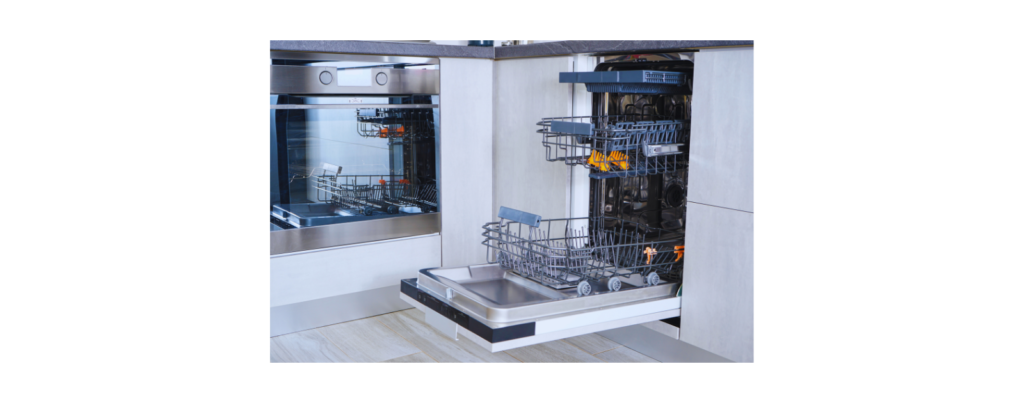Dishwashers are an unsung hero in most kitchens, but like any hardworking appliance, they need a little TLC to stay in top condition. Follow this guide for an easy and thorough cleaning process to keep your dishwasher fresh and running efficiently.
Step 1: Gather Your Supplies

You’ll need:
- Damp cloth or microfiber cloth
- Distilled white vinegar
- Baking soda
- Mild dish soap
- Soft toothbrush or old toothbrush
- Dishwasher-safe bowl
- Paper towel
Having all your supplies ready before you start ensures a smooth cleaning process.
Step 2: Start With the Exterior
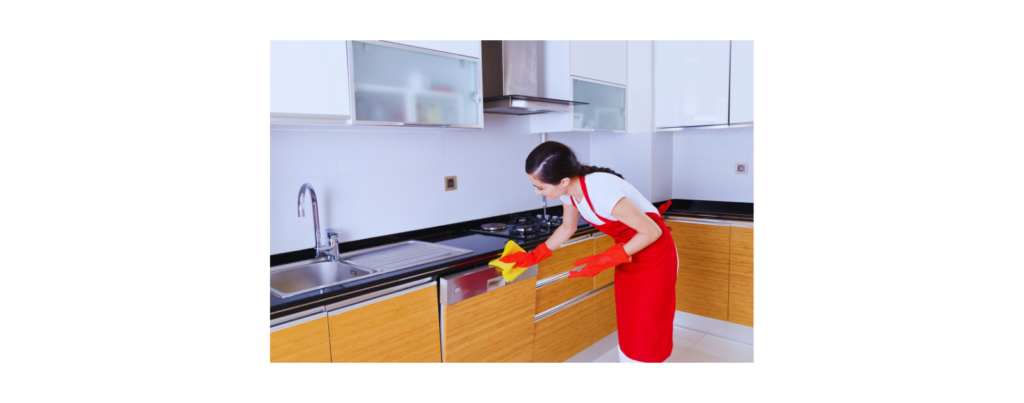
Wipe down the dishwasher’s exterior with a damp microfiber cloth or paper towel. For stainless steel surfaces, consider using a stainless steel cleaner or a mix of vinegar and water to prevent streaks. Focus on areas like the door handle and control panel, which are touched frequently and prone to smudges.
Step 3: Tackle the Door Seal
Inspect the door gasket and rubber seal for soap residue, food debris, or mildew. Use a soft toothbrush and warm, soapy water to clean it thoroughly. Pay attention to corners and crevices where grime tends to accumulate. Keeping this area clean helps maintain a tight seal and prevents leaks.
Step 4: Clean the Spray Arms
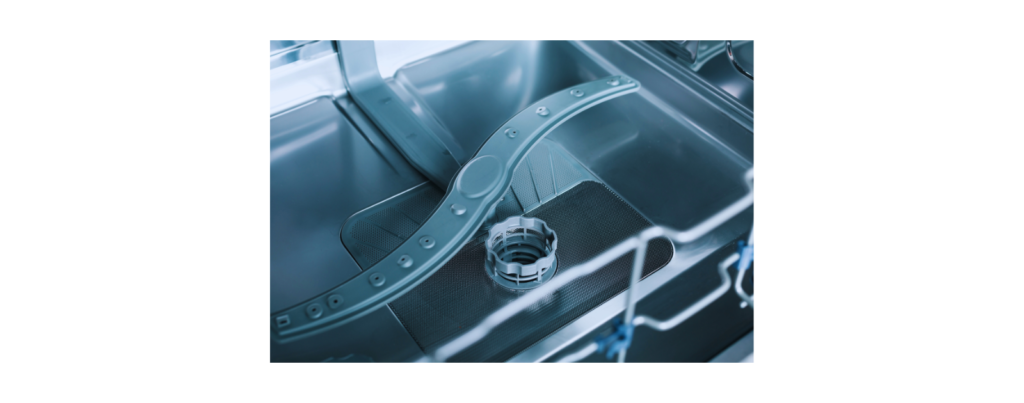
Remove the bottom rack to access the spray arms. Check the tiny holes for food particles or mineral buildup, which can block water flow and reduce cleaning efficiency. Use a toothpick, a small brush, or compressed air to clear blockages. Rinse under warm water to ensure the spray arms are fully clean.
Step 5: Empty and Inspect the Filter
Most dishwashers have a filter at the bottom that catches food debris. Remove it (refer to your owner’s manual for specific instructions) and rinse under warm water. Use a soft brush and mild soap to scrub away grease and stubborn debris. Cleaning the filter regularly prevents clogs and unpleasant odors.
Step 6: Deep Clean With Vinegar and Baking Soda
- Vinegar Cycle: Place a dishwasher-safe bowl filled with one cup of white vinegar on the top rack. Run a hot water cycle. The vinegar breaks down grease, removes mineral buildup, and eliminates odors.
- Baking Soda Cycle: After the vinegar cycle, sprinkle one cup of baking soda across the bottom of the dishwasher. Run a short, hot water cycle. Baking soda deodorizes and brightens the interior, leaving your dishwasher smelling fresh.
Step 7: Handle Soap Scum and Stubborn Residue
For heavy soap scum, create a paste using baking soda and water. Apply it to affected areas and scrub gently with a toothbrush. Alternatively, use a commercial dishwasher cleaner designed to remove stubborn residue. Follow the product’s instructions for the best results.
Step 8: Clean the Garbage Disposal
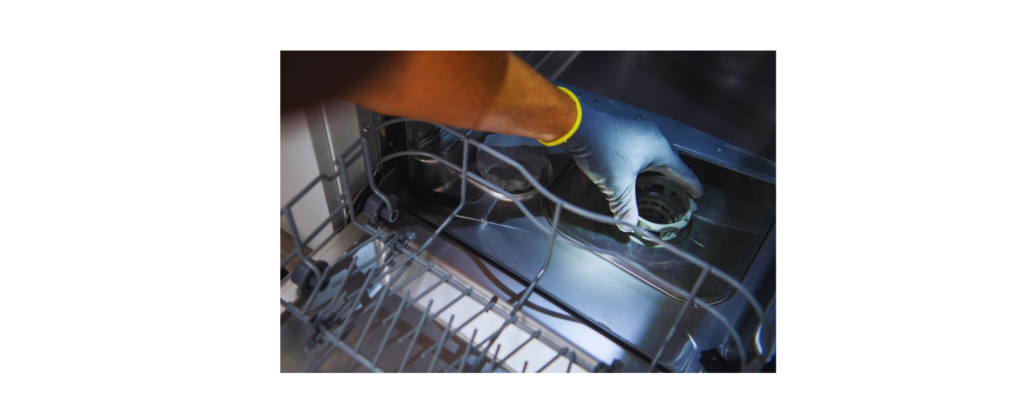
Ensure the garbage disposal in your sink is clean, as it’s connected to the dishwasher’s drainage system. Run cold water and turn on the disposal to clear any food debris. This step prevents unpleasant odors and ensures proper drainage.
Step 9: Check and Refill Rinse Aid
Rinse aid helps prevent water spots and keeps dishes shiny. Locate the dispenser, usually near the detergent compartment, and refill it if needed. This simple step improves drying performance and enhances the appearance of your dishes.
Step 10: Air Dry
After the cleaning cycle, leave the dishwasher door open to air dry completely. This prevents mold and mildew growth and keeps the interior fresh. For added freshness, place a small container of baking soda or activated charcoal inside to absorb odors.
Maintaining a Regular Cleaning Schedule
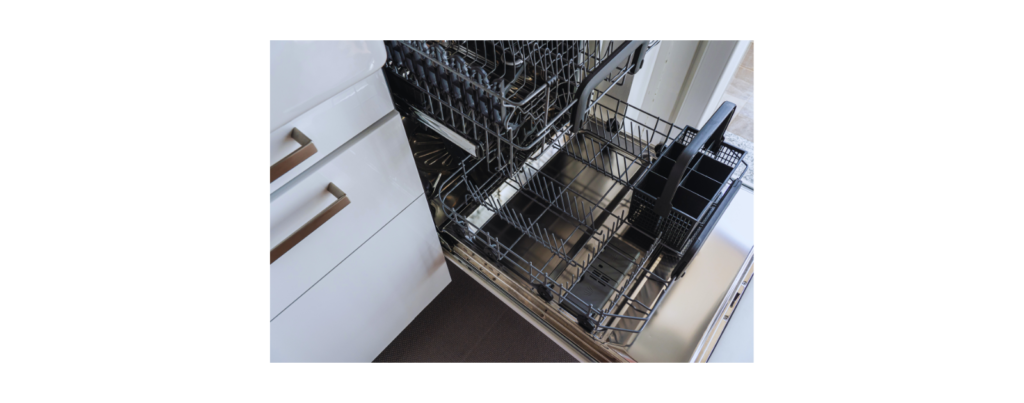
- Weekly: Wipe the door and rubber seal, and check for visible debris. Run a quick vinegar cycle if necessary.
- Monthly: Deep clean with vinegar and baking soda, and clean the filter. Inspect the spray arms for clogs.
- Quarterly: Inspect spray arms, run a commercial dishwasher cleaner, and deep clean the entire unit.
FAQs About Dishwasher Cleaning
1. How often should I clean my dishwasher?
Weekly for surface cleaning, monthly for deep cleaning, and quarterly for a more thorough inspection.
2. Can I use bleach to clean my dishwasher?
Avoid bleach, especially if your dishwasher has stainless steel parts, as it can cause damage. Use vinegar or baking soda instead.
3. What if my dishwasher still smells after cleaning?
Check for clogs in the filter, garbage disposal, and spray arms. Ensure the drain is clear and run another vinegar cycle.
4. Can I use lemon juice instead of vinegar?
Yes, but vinegar is more effective for removing mineral buildup. Lemon juice, however, leaves a pleasant citrus scent.
5. Why is my dishwasher leaving spots on glasses?
Refill the rinse aid dispenser, ensure you’re using the right amount of detergent, and check if your water is too hard. A rinse aid or water softener can help.
6. Can I clean my dishwasher with dishes inside?
It’s best to clean an empty dishwasher to allow full access to all components and ensure proper cleaning.
With these detailed steps and a little regular maintenance, your dishwasher will stay fresh, efficient, and ready to tackle even the dirtiest dishes!

